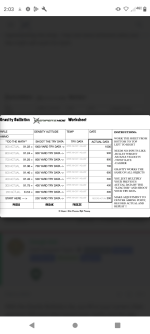Hi all,
I have two rifles chambered in 6.5 Creedmoor (Ruger RPR and Accuracy International AT-X) both with Vortex Razor HD Gen 2 scopes. I shoot at a range with known distances from 100-1200 yards in 100 yard increments.
My rifles are zeroed for 100 yards and I have dope settings for 100, 200, 300 and 600 yards. I've tried a variety of different calculators (Hornady 4DOF, Vortex, several others). They all seem consistent in their come up values which don't match either of my rifles. For instance with the RPR at 600 yards they state around 12.8MOA come up while I have to actually dial 14.5 - a big difference! With the AI, the calculators state 1.35 come up at 200 yards when I actually have to dial -0.25 from my 100 yard zero.
I'm using a Garmin chrono so have accurate MV. I'm using Hornady ELDM 147gr factory ammo so know the bullet weight, am specifying barrel twist, sight height over barrel, temperature etc.
Is there an explanation why the calculators seem so far off vs my two rifles?
I want to shoot at 1000 yards and have no dope for that. How can I use a calculator to determine that? Should I change the bullet G7 BC to accurately match the come up at 600 yards and then use the 1000 yard figure the calculator then suggests?
All gems of experience welcome!
Thanks.
Graham
I have two rifles chambered in 6.5 Creedmoor (Ruger RPR and Accuracy International AT-X) both with Vortex Razor HD Gen 2 scopes. I shoot at a range with known distances from 100-1200 yards in 100 yard increments.
My rifles are zeroed for 100 yards and I have dope settings for 100, 200, 300 and 600 yards. I've tried a variety of different calculators (Hornady 4DOF, Vortex, several others). They all seem consistent in their come up values which don't match either of my rifles. For instance with the RPR at 600 yards they state around 12.8MOA come up while I have to actually dial 14.5 - a big difference! With the AI, the calculators state 1.35 come up at 200 yards when I actually have to dial -0.25 from my 100 yard zero.
I'm using a Garmin chrono so have accurate MV. I'm using Hornady ELDM 147gr factory ammo so know the bullet weight, am specifying barrel twist, sight height over barrel, temperature etc.
Is there an explanation why the calculators seem so far off vs my two rifles?
I want to shoot at 1000 yards and have no dope for that. How can I use a calculator to determine that? Should I change the bullet G7 BC to accurately match the come up at 600 yards and then use the 1000 yard figure the calculator then suggests?
All gems of experience welcome!
Thanks.
Graham



